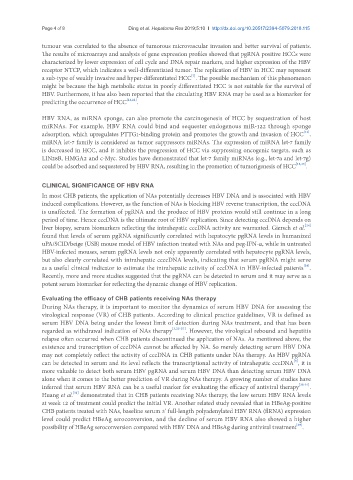Page 126 - Read Online
P. 126
Page 4 of 8 Ding et al. Hepatoma Res 2019;5:10 I http://dx.doi.org/10.20517/2394-5079.2018.115
tumour was correlated to the absence of tumorous microvascular invasion and better survival of patients.
The results of microarrays and analysis of gene expression profiles showed that pgRNA positive HCCs were
characterized by lower expression of cell cycle and DNA repair markers, and higher expression of the HBV
receptor NTCP, which indicates a well-differentiated tumor. The replication of HBV in HCC may represent
[7]
a sub-type of weakly invasive and hyper-differentiated HCC . The possible mechanism of this phenomenon
might be because the high metabolic status in poorly differentiated HCC is not suitable for the survival of
HBV. Furthermore, it has also been reported that the circulating HBV RNA may be used as a biomarker for
predicting the occurrence of HCC [21,22] .
HBV RNA, as miRNA sponge, can also promote the carcinogenesis of HCC by sequestration of host
miRNAs. For example, HBV RNA could bind and sequester endogenous miR-122 through sponge
[14]
adsorption, which upregulates PTTG1-binding protein and promotes the growth and invasion of HCC .
miRNA let-7 family is considered as tumor suppressors miRNAs. The expression of miRNA let-7 family
is decreased in HCC, and it inhibits the progression of HCC via suppressing oncogenic targets, such as
LIN28B, HMGA2 and c-Myc. Studies have demonstrated that let-7 family miRNAs (e.g., let-7a and let-7g)
could be adsorbed and sequestered by HBV RNA, resulting in the promotion of tumorigenesis of HCC [15,23] .
CLINICAL SIGNIFICANCE OF HBV RNA
In most CHB patients, the application of NAs potentially decreases HBV DNA and is associated with HBV
induced complications. However, as the function of NAs is blocking HBV reverse transcription, the cccDNA
is unaffected. The formation of pgRNA and the produce of HBV proteins would still continue in a long
period of time. Hence cccDNA is the ultimate root of HBV replication. Since detecting cccDNA depends on
[24]
liver biopsy, serum biomarkers reflecting the intrahepatic cccDNA activity are warranted. Giersch et al.
found that levels of serum pgRNA significantly correlated with hepatocyte pgRNA levels in humanized
uPA/SCID/beige (USB) mouse model of HBV infection treated with NAs and peg-IFN-α, while in untreated
HBV-infected mouses, serum pgRNA levels not only apparently correlated with hepatocyte pgRNA levels,
but also clearly correlated with intrahepatic ccccDNA levels, indicating that serum pgRNA might serve
[24]
as a useful clinical indicator to estimate the intrahepatic activity of cccDNA in HBV-infected patients .
Recently, more and more studies suggested that the pgRNA can be detected in serum and it may serve as a
potent serum biomarker for reflecting the dynamic change of HBV replication.
Evaluating the efficacy of CHB patients receiving NAs therapy
During NAs therapy, it is important to monitor the dynamics of serum HBV DNA for assessing the
virological response (VR) of CHB patients. According to clinical practice guidelines, VR is defined as
serum HBV DNA being under the lowest limit of detection during NAs treatment, and that has been
regarded as withdrawal indication of NAs therapy [3,25-27] . However, the virological rebound and hepatitis
relapse often occurred when CHB patients discontinued the application of NAs. As mentioned above, the
existence and transcription of cccDNA cannot be affected by NA. So merely detecting serum HBV DNA
may not completely reflect the activity of cccDNA in CHB patients under NAs therapy. As HBV pgRNA
[6]
can be detected in serum and its level reflects the transcriptional activity of intrahepatic cccDNA , it is
more valuable to detect both serum HBV pgRNA and serum HBV DNA than detecting serum HBV DNA
alone when it comes to the better prediction of VR during NAs therapy. A growing number of studies have
inferred that serum HBV RNA can be a useful marker for evaluating the efficacy of antiviral therapy [28-31] .
[31]
Huang et al. demonstrated that in CHB patients receiving NAs therapy, the low serum HBV RNA levels
at week 12 of treatment could predict the initial VR. Another related study revealed that in HBeAg-positive
CHB patients treated with NAs, baseline serum 3’ full-length polyadenylated HBV RNA (flRNA) expression
level could predict HBeAg seroconversion, and the decline of serum HBV RNA also showed a higher
[29]
possibility of HBeAg seroconversion compared with HBV DNA and HBsAg during antiviral treatment .

